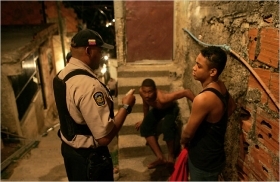With Venezuela’s homicides climbing to dramatic rates, rising by a third in 2011, it seems more urgent than ever to reduce the huge number of firearms circulating among civilians.
According to Venezuela’s main police agency, known by its acronym the CICPC, there were 18,850 murders in 2011, a 30 percent increase from the previous year.
Another count by watchdog group the Venezuelan Violence Observatory (OVV), which says it bases its numbers on police reports, maintains that 2011 was most violent year in Venezuela’s history, with 19,336 homicides. That would put the national homicide rate at 67 per 100,000 inhabitants.
There is one short-term solution that could slow the tide of violence: a well-funded disarmament campaign to reduce the number of firearms on the street. This approach alone will probably do little good if it does not form part of a wider strategy to reduce crime rates and impunity. But the government needs to prove their commitment to taking guns from the hands of civilians, especially after years of arming civilian militias for political purposes.
According to a 2009 survey by Venezuela’s National Statistics Institute (INE), which covered over 20,000 households, 79 percent of homicides and kidnappings and 74 percent of robberies are committed with guns. Another study by the International Action Network on Small Arms (IANSA) found that 79 percent of all homicides carried out between June 2008 and and June 2009 involved firearms.
There is also evidence that these guns are widely available among the poorest and youngest sectors of Venezuela’s population. Gun violence disproportionately affects those between 15 and 29 years old, while Venezuela’s two lowest socioeconomic groups made up 80 percent of all homicide victims in 2009, according to INE. Meanwhile, Venezuela’s highest socioeconomic class only experienced two percent of all crimes.
Two important legal steps have been taken towards disarmament in Venezuela. The first, passed in 2002, requires gun owners to register their weapons in military records. A stricter law, passed in 2010, but not yet implemented, would sentence gun traffickers to up to 16 years in prison. In December 2011, the government announced a series of stricter gun controls to be put in effect for the next three months, which includes banning the possession of firearms in public places. This was an extension of the stricter regulations first enforced in September 2011, as InSight Crime reported at the time.
The government has taken previous measures to take guns off the streets, including one disarmament campaign that reportedly resulted in the destruction of 50,000 firearms last year. Nevertheless, an ongoing concern is that the number of guns distributed among volunteer militia units provides an easy supply of firearms among the civilian population. There are thought to be hundreds of thousands of members of umbrella militia organization the National Bolivarian Militia (MNB). The recruits are trained and equipped with weapons and there is little oversight over what filters through to the black market.
President Hugo Chavez and his defenders argue that Venezuela experienced steadily rising crime and homicide rates before he took office. Another argument is that impunity and police corruption are problems that pre-existed his administration. These points are valid, but outdated.
And considering that the 2011 police data on homicides coincides so closely with OVV’s count, it will be hard to argue against the reality that violence has accelerated rapidly under the Chavez administration. And it will be impossible to deny that one of the major reasons for this intensification is the wider avaliability of firearms.

